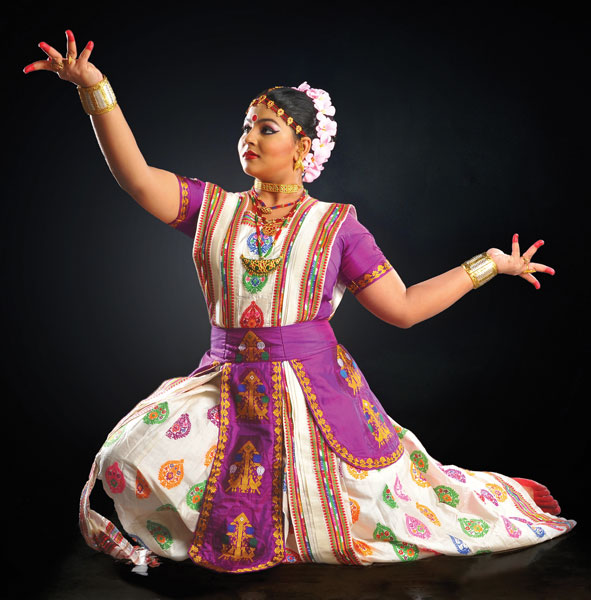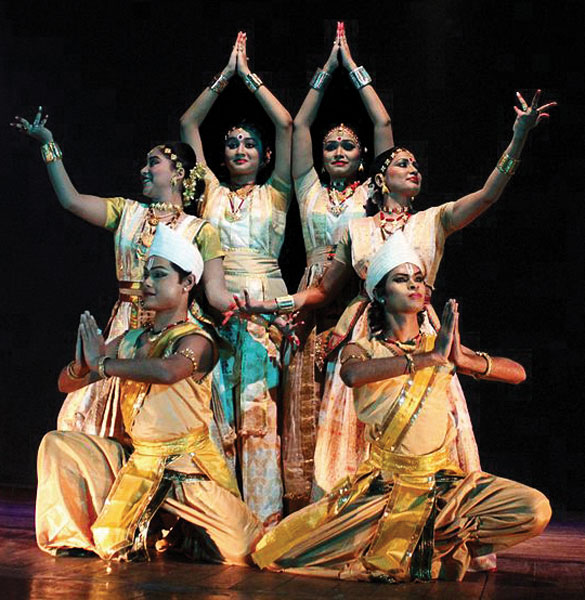Sattriya — the dance of the monks The truest expression of a people is in its dance and its music. Bodies never lie. — Agnes de Mille
It is believed that the origin of theatre art in India was the work of God. Brahma, the creator, was asked to give mankind a fifth Veda, which, unlike the four earlier Vedas in Sanskrit, would be easily understood by everyone. Brahma created the Natya Veda with the assistance of other gods and taught the mythic sage Bharatha who recorded his teachings in the Natya Sastra. It became the foundational treatise of all classical forms of theatre and dance in India and is probably the world’s largest and most comprehensive art manual. There are eight classical dance forms in India based on the Natya Sastra. Sattriya, originating from Assam, was officially recognised by the Sangeet Natak Akademi as the eighth classical dance form only in the beginning of the 21st century although it was performed exclusively by male monks in the Vaishnavaite monasteries known as Sattra for many centuries. The monks or bhokots, as they were referred, used to describe the legends of Krishna from the Bhagavatha Purana in a dance-drama format as part of their daily rituals. Mahapurush Simanta Sankaradeva brought this dance to the mainstream in the 15th century by systematising it using ancient texts and introducing drama and expressive dance (nritta and nritya) to express devotion to Krishna. Sattriya gained popularity through the Vaishnava Bhakti movement and evolved as a classical art over the last five centuries. It is now performed by both men and women who are not necessarily members of the satras (the religious institutions). The dancers have diversified the repertoire by including Saivaite themes and also exploring beyond mythology.
The dance
Sattriya is traditionally performed before a copy of the Bhagavata Purana placed in the Manikut or eastern corner of the dance hall known as namghar and not in front of any idol. There are many styles like the sutradhara or sutra-bhangi, character specific bhangi, prabesh, nritya and jhumura. The sutradhara presents the spiritual values of Vaishnavism in a complete classical format of nritta, nritya and natya, with a commentary in the local language for the audience’s comprehension. Ankiya nat is a sub-genre consisting of one-act plays that feature a ballad, dance and drama which are usually performed in the dance community halls of the monasteries. The themes generally relate to Krishna and Radha and also other manifestations of Vishnu in different avatars. Many of the dancedramas that are popular even today were written and composed by the Assamese poet-saint Sankaradeva and his principal disciple Madhavadeva during the 15th and 16th centuries. The Sangita Ratnakara of Shankaradeva complements his Bhakti Ratnakara, which traces the Upanishads, Bhagavad Gita, Yoga and Vedanta themes and also includes ethical values like non-violence and truth which provide a theological foundation to Sattriya. Shankaradeva appealed to the leaders of Hindu monasteries to compose at least one play during their tenure as he believed that religious values and the joys of life were closely interlinked with performance arts.
The Sattriya repertoire (marg) integrates two styles, one masculine known as Paurashik bhangi that is energetic with leaps and jumps and the feminine or Stri bhangi, which includes graceful movements. Like all major classical Indian dance forms, Sattriya includes nritta (pure dance), nritya (expressive dance) and natya (dramatic play). The nritta performance is abstract, rhythmic movement where the emphasis is on technical virtuosity. In nritya the performance expands to include storytelling through gestures, body movements and facial expressions. The natya is a play, typically a group performance, but can be performed as a solo where the dancer uses standardised body movements to indicate different characters in the story. The basic dance unit of Sattriya is called a Mati akhara. While describing the abhinaya or facial expressions in Sattriya: the Redefining of a Tradition, Arshiya Sethi, scholar and arts manager says, the distinctive Sattriya abhinaya defies elitist leanings by depicting activities like fighting, eating, slaying, killing etc which were frowned upon by the Sanskrit texts.
Costume
The Sattriya costume reflects the ethnicity of the Assamese. Male dancers wear dhoti, chadar and the paguri (turban) and the woman dancer wears a ghuri, chadar and kanchi (waist cloth). They are made from white or unbleached raw silk with colours such as red, blue and yellow used for specific dances and characters. Velvet and satin were used earlier but when the dance moved from the satras to the stage, the design and materials changed. Nowadays, pat, a silk derived from mulberry plant and the golden-hued Muga silk produced in Assam are mostly used. The female dancers use bright coloured hand-woven material with intricate local motifs representing the flora and fauna of the region. The costumes of Ankiya naat are colourful and character-specific and beautifully decorated turbans and crowns made by the local artisans are also used.
The dress of Krishna nritya and Nadubhangi nritya is yellow and blue to denote Lord Krishna. The Sutradhar Nritya also has a specific white costume with a special turban. A unique feature of this dance form is the use of mukha (masks) to depict demons and special characters. The art of mask-making is an integral part of Sattriya culture. Traditional Assamese jewellery made in unique Kesa Sun or raw gold is used for ornamentation. Artists wear Kopali on the forehead, different type of neck pieces in different shapes like golpata, dhulbiri (musical instrument dhol), bena (crescent), jethipata (lizard), dugdugi (leaf), senpata (eagle), and dhansira (rice grain) with matching ear rings and bracelets called muthi kharu and gam kharu. The female dancers adorn themselves with a red bindi on the forehead and white flowers in the hair.

Sattriya Nritya is accompanied by musical compositions called borgeet which are based on classical ragas. A key musical accompaniment is the Khol which is an asymmetrical drum quite different from the rest of India. The special shape and material used such as clay, wood, leather, rice dough, iron filings and rope straps produce a high pitch on the right side (daina), and a deep bass sound on the left (bewa). The other accompaniments are the flute and more recently, the violin and harmonium. In addition, they include various types of talas or cymbals (Manjira, Bhortal, Bihutal, Patital, Khutital) to infuse religious fervour.
Indira P P Bora is a pioneer dancer who has contributed significantly to the recognition and patronage of Sattriya. She learned the dance under Rosheswar Saikia Barbayan, Ghana Kant Bora and Pradip Chaliha. She has trained many dancers in Sattriya since 1982, including her daughter Dr Menaka P P Bora at her institution, ‘Kalabhumi’, in Guwahati. Menaka is continuing in her mother’s footsteps and taking giant strides to further garner worldwide recognition for this dance.
The classical dances of India have survived for so many centuries and passed on for generations. They remain relevant even today as they are perpetually evolving. Shah Azad Rizvi rightly said, “Dance is the timeless interpretation of life. It is as appealing when performed for the gods in religious places as for audiences on international metropolitan stages.” As American dancer Merce Cunningham said, “You have to love dancing to stick to it. It gives you nothing back, no manuscripts to store away, no paintings to show on walls and maybe hang in museums, no poems to be printed and sold, nothing but that single fleeting moment when you feel alive.”


